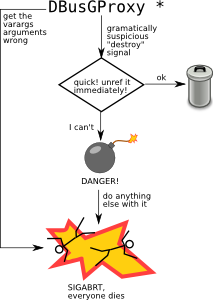
Developers seem to do a lot of fighting with bleeding-edge libraries installed
in a --prefix, so I thought I'd share how I develop telepathy-glib (a library)
and telepathy-gabble (a program using that library).
~/Collabora/telepathy/tpglib on my laptop is a git clone of
telepathy-glib.git, branched using the process I documented on
http://telepathy.freedesktop.org/wiki/Git, which is basically:
- clone the upstream repository
(git+ssh://git.collabora.co.uk/git/telepathy-glib.git in this case)
into your home directory on the server
(git+ssh://people.collabora.co.uk/home/smcv/public_html/git/telepathy-glib-smcv.git in this case)
- clone that onto your laptop
- on your laptop, add "upstream" as a remote, tracking the upstream repository
- this reduces mistakes, because "git push" pushes to origin (which is in my
home directory) for review, and "git push upstream" is necessary when I
actually want to commit to the upstream repository
~/Collabora/telepathy/gabble is a git clone of telepathy-gabble.git, using the
same process.
In my Gabble checkout, I used to configure like this:
cd ~/Collabora/telepathy/gabble
./autogen.sh \
TP_GLIB_CFLAGS="-I$ HOME /Collabora/telepathy/tpglib" \
TP_GLIB_LIBS="$ HOME /Collabora/telepathy/tpglib/telepathy-glib/libtelepathy-glib.la"
This would make libtool link Gabble against the copy of telepathy-glib built by
my bleeding-edge git checkout, without ever needing to install it.
This allowed me to try out my latest telepathy-glib changes with
Gabble's more extensive regression tests, which was a great win.
It also meant I could develop Gabble branches that required a not-yet-released
telepathy-glib, and all without touching my system copy of telepathy-glib
(the one I use to run Empathy and talk to people - which is the packaged
version from Debian unstable or experimental).
The reason I could do this is that I laid out the telepathy-glib source tree in
The Right Way , which is: if a header is designed to be used via
#include <my-library/foo.h>, then it goes in a
my-library/ directory
in the source tree, and includes other headers (even from the same project)
with
#include <my-library/other.h>.
This means you can just add the top directory of the source tree to your
include path (which automake does by default) and the right thing will happen.
(Actually, this is a slight simplification of the truth: because telepathy-glib
contains generated headers, you have to add the top directory of the
build
tree to your include path too, if you want to support out-of-tree builds.
Which, of course, you do.)
Other projects that do this correctly include GLib and Avahi. Avahi is a
particularly interesting example because it has numerous libraries in the same
tarball (including avahi-common, avahi-core, avahi-glib and avahi-gobject,
which form a dependency chain).
Projects that
don't do this correctly include telepathy-mission-control
(which is on my hit list for further swamp-draining) and libtelepathy (which
is obsolete).
Today I committed a patch to telepathy-glib, inspired by GStreamer, to
generate telepathy-glib-uninstalled.pc.
The presence of this patch simplifies the process further, to:
./autogen.sh PKG_CONFIG_PATH=$HOME/Collabora/tpglib/telepathy-glib
This has the same benefits as setting TP_GLIB_CFLAGS and TP_GLIB_LIBS,
but is easier to remember, and is more future-proof against changes to
telepathy-glib.
It only works because pkg-config has a special case for this situation -
if you ask for the package "foo", pkg-config will always look for
foo-uninstalled.pc before foo.pc.
(Edited 2009-01-13: putting environment variables on the ./configure or
./autogen.sh command line like
./autogen.sh PKG_CONFIG_PATH=foo is better
than putting them in the environment like
PKG_CONFIG_PATH=foo ./autogen.sh,
since it works around
Debian bug #398901
and bugs like it)
 Debian's latest round of angry mailing list threads have been about some
combination of init systems, future direction and project governance.
The details aren't particularly important here, and pretty much everything
worthwhile in favour of or against each position has already been said several
times, but I think this bit is important enough that it bears repeating:
the reason I voted "we didn't need this General Resolution" ahead
of the other options is that I hope we can continue to use our normal
technical and decision-making processes to make Debian 8 the best possible
OS distribution for everyone. That includes people who like systemd,
people who dislike systemd, people who don't care either way and just
want the OS to work, and everyone in between those extremes.
I think that works best when we do things, and least well when a lot
of time and energy get diverted into talking about doing things.
I've been trying to do my small part of the former by
Debian's latest round of angry mailing list threads have been about some
combination of init systems, future direction and project governance.
The details aren't particularly important here, and pretty much everything
worthwhile in favour of or against each position has already been said several
times, but I think this bit is important enough that it bears repeating:
the reason I voted "we didn't need this General Resolution" ahead
of the other options is that I hope we can continue to use our normal
technical and decision-making processes to make Debian 8 the best possible
OS distribution for everyone. That includes people who like systemd,
people who dislike systemd, people who don't care either way and just
want the OS to work, and everyone in between those extremes.
I think that works best when we do things, and least well when a lot
of time and energy get diverted into talking about doing things.
I've been trying to do my small part of the former by

 There are several friends and family I want to be able to call with free software. The only way I could make it accessible to them was to burn
There are several friends and family I want to be able to call with free software. The only way I could make it accessible to them was to burn  WebRTC has been in the most recent stable releases of
WebRTC has been in the most recent stable releases of 
 Users have
Users have  In fact, this is more useful than one can imagine, because a
considerable amount of time in periodic RC squashing is taken by
triaging the RC bug list to choose your targets. Of course there is
no guarantee that I'll be willing/able to fix handed-over bugs but,
as a RM, Luk has evidently well-trained feelings about how hard
would be to fix a given bug. All in all, for this week it worked
well: 4 of the above 7 came from
In fact, this is more useful than one can imagine, because a
considerable amount of time in periodic RC squashing is taken by
triaging the RC bug list to choose your targets. Of course there is
no guarantee that I'll be willing/able to fix handed-over bugs but,
as a RM, Luk has evidently well-trained feelings about how hard
would be to fix a given bug. All in all, for this week it worked
well: 4 of the above 7 came from 
 The Debian Python Modules Team is
The Debian Python Modules Team is 
